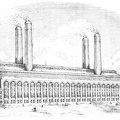The coaches that travelled between London and distant towns were similar in construction to the hackney coach, which plied for hire in the streets, but were built on a larger scale. They carried eight passengers inside, and behind, over the axle, was a great basket for baggage and outside passengers, who made themselves as comfortable as they might in the straw supplied. The “insides” were protected from rain and cold by leather curtains; neither passengers nor baggage were carried on the roof; and the coachman sat on a bar fixed between the two standard posts from which the body was hung in front, his feet being supported by a footboard on the perch.
Mr. Thrupp states that in 1662 there were only six stage coaches in existence; which assertion does not agree with that of Chamberlayne, quoted on a previous page; the seventeenth century writer tells us that in his time—1649—stage coaches ran “from London to the principle towns in the country.” It seems, however, certain that the year 1662 saw a great increase in the number of “short stages”—that is to say, coaches running between London and towns twenty, thirty, forty miles distant.
- Author
- Title: Early Carriages and Roads
Author: Walter Gilbey
Pulished in 1903
Available from gutenberg.org - Posted on
- Monday 25 October 2021
- Dimensions
- 825*491
- Tags
- Century:17th, Horse, Transport
- Albums
- Technology / Transport / Land / Horse Powered
- Visits
- 1309
- Downloads
- 52
 Download Photo
Download Photo





